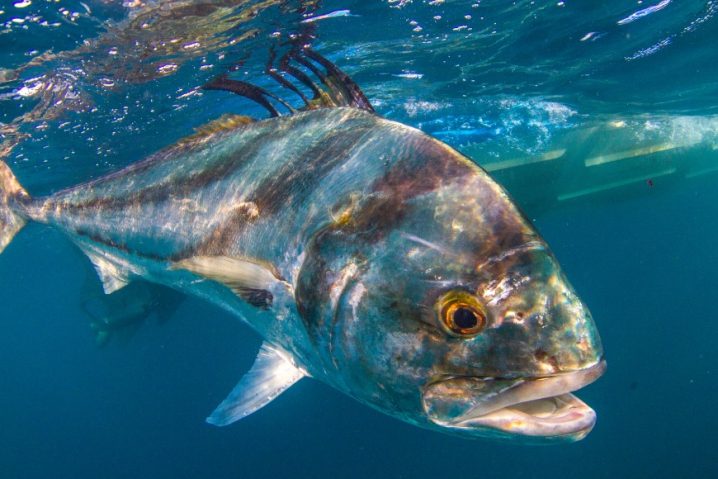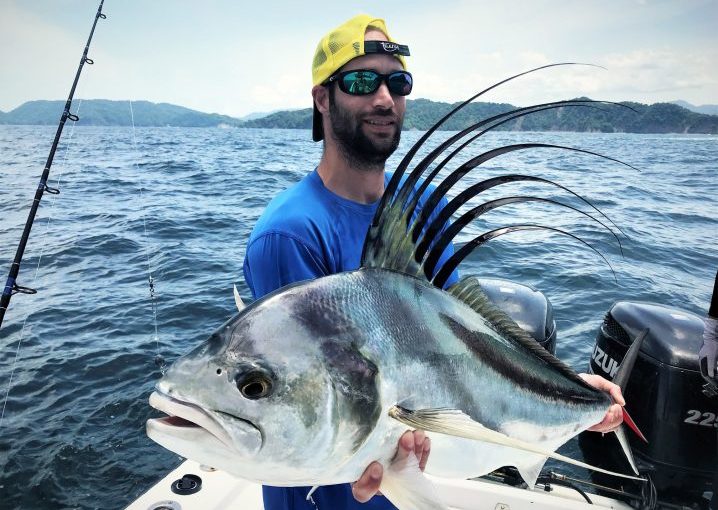Costa Rica’s Famous Roosterfish Finally Gets its’ Own Tournament!
Costa Rica’s 1st International Tournament Set to Kickoff November 16th, 2018 ( Enter Here ) at Crocodile Bay Resort in Costa Rica’s South Pacific.
Costa Rica really hit the jackpot when it comes to sportfishing. From the river mouths to the bluewaters and way inland, the country is bursting with monster gamefish. But of all the fish out there, it’s the Roosterfish Costa Rica anglers are really proud of.
Funny, then, that there’s no Roosterfish tournament in Costa Rica. But now there is. On November 16 this year, Golfo Dulce’s Crocodile Bay Resort will kick off the first International Roosterfish Tournament. Teams will travel from the US, Canada, Mexico, Panama, and of course, Costa Rica itself to take part.

Who is organizing the event? Why Costa Rica? What can we expect in years to come? We got in touch with some of the organizers to find out. From what we heard, it sounds like the teams are in for a treat!
What’s the Big Deal with Roosterfish?
Roosterfish are one of those species that can get you hooked from the first time you see them. They’re unlike anything else out there. Their wild mohawk and blue shimmer scream for a camera. Try catching one, and it’s the reel that starts screaming.
Roosterfish fight hard and don’t give in easy. The way they move is erratic, bordering on berserk. They have enough power to break your line and burn your drag if you’re not careful. They’re made even more interesting by the fact that you can’t catch them in the US. It’s easy to see why some anglers spend their lives chasing Roosters around Central America.
You can catch Roosterfish all the way from the north of Mexico to the south of Peru, but very few fisheries compare to Costa Rica. Sure, Baja might have the world record, but Costa Rica has some real monsters, too. And that’s just part of what makes the area unique.

Why Golfo Dulce?
“We catch Roosters everywhere here” – says tournament organizer Todd Staley – “We catch them on the reefs. We’ve caught them in over 200 feet. We’ve caught them in the middle of the gulf away from the shoreline.”
This will come as a surprise to anyone who has tried Roosterfishing farther north. In Mexico, Roosters are only really caught along the surf line. Most anglers wouldn’t think of targeting them in more than a couple of fathoms of water. Not so in Costa Rica, clearly.
The fish don’t lack for size, either. According to Beau Williams, Crocodile Bay’s General Manager, Roosters can hit 100 pounds or more in Golfo Dulce. Sure, these aren’t your everyday catch, but on any given week they pull in plenty of fish in the 40-60 lb range.
What draws Roosterfish to the gulf? Several things, says Williams. “It generates an abundance of bait fish that Roosters prefer – sardines, mullet, goggle-eyes, blue runners, moonfish, and bonita.” He also points to the mix of sandy beaches and volcanic rock outcroppings. This all adds up to year-round Roosters. Sure sounds like a good place for a Roosterfish tournament.

The PanAmerican Delegation: Big Fish, Big Dreams
So who exactly is organizing the tournament? The people behind the event are the PanAmerican Sportfishing Delegation. They organize tournaments all across the Americas. They have two Bass tournaments, a Snook Tournament, and as of this year, a Roosterfish Tournament.
The Delegation’s aim is to get sportfishing recognized in the Pan American Games. Eventually, they even want to see it in the Olympics. For now, though, they’re happy putting on tournaments and building friendships through fishing. That’s exactly what they’re doing in Costa Rica.
The PanAm Delegation has partnered with FECOP, a Costa Rican non-profit which focuses on protecting the country’s fisheries. This is where Staley came in. He has worked with FECOP since it was first created in 2008. He also worked at Crocodile Bay for the best part of 20 years. This made him the perfect man to help set up the event.
Staley brought the tournament committee to Golfo Dulce and showed them around several resorts in the area. Crocodile Bay came out the clear winner because of its size and easy access to Puerto Jimenez Airport. It also has a large fleet of well-maintained, near-identical boats. This gives each team the same chance of landing a winner.

The committee found the spot for their tournament. It was time to get the teams together. It didn’t take long for the word to spread. A dozen teams from five countries signed up and will be heading down to Crocodile Bay in search of the biggest Roosterfish Costa Rica has to offer.
Catching Roosterfish Costa Rica-Style
One of the many things that makes Costa Rica great is the country’s dedication to responsible fishing. Billfish and Roosterfish are catch-and-release only and circle hooks are the norm on most boats. Local groups like FECOP work hard to keep the fishing sustainable, especially during tournaments.
In keeping with this, the PanAmerican Roosterfish Tournament is entirely catch-and-release. The fish won’t even be weighed. As Staley explains, “we’re not weighing the fish because they have to be out of the water and it’s too much of a strain on them.” Instead, teams will measure each Rooster they catch and submit their top ten every day. The healthiest fish will also be tagged to help scientific study into their movements.
A Roosterfish ready to swim off and fight another day.
How will the teams be fishing? That’s up to them. Tournament rules say up to 30lb line and no treble-hooks with natural baits, but other than that, anything goes. We asked Staley for some of his top tips for bringing in big Roosters and he gave some sound advice:
“Here’s my analogy of a Roosterfish: They’re dumb as a rock to a live bait. You can fool them with a popper, or a jig, or an artificial. No-one’s found the holy grail yet on the fly. Fish all the columns of water – don’t just concentrate on the surf or the surface. Try it deep, try it on the surface – they’re gonna be someplace.”
A Big Deal Locally?
It sounds like everyone involved is going to have a blast, but what does it mean to the town? Many tournaments pass the local community by, especially when they’re organized from abroad. Williams says that isn’t the case here, though.
“The locals in this area are extremely excited to have an international tournament,” he says, explaining how the tournament trail has largely missed the south of the country. “While many experienced captains in our area have also fished professionally in Quepos for their Billfish tournaments, they are very excited to get Puerto Jimenez on the map.”
Staley also says that Golfo Dulce’s Rooster fishery doesn’t get the attention it deserves. That’s part of the reason for the tournament: “There’s plenty of other Sailfish, Marlin, and Dorado tournaments in the country,” he says, “Nobody’s really doing an all-Roosterfish tournament.”

So how involved is the local community? Not hugely, at least for this year. Staley is sticking to his golden rule of “keep it simple, stupid.” This is the tournament’s first year, after all.
That’s not to say they’re not involved at all. There will be a presentation by the head of the local fish board and a performance put on by the local school. The captains and crews will also be from the area, but the Costa Rican teams won’t – it would be a little unfair if some teams were fishing their own backyard, we guess.
What’s next?
“The Pan-American Delegation was formed less than 2 years ago.” Explains Staley. “It’s in its infancy but hopefully it will take off.” He says that organizations in Europe have had a lot longer to get going and that the PanAm is still catching up. If that’s the case, they’re catching up fast. They already have four tournaments in three countries, fishing both saltwater and freshwater.
This is the first PanAmerican tournament held in Costa Rica, but it won’t be the last. If everything goes well, we could also see a Tarpon tournament sometime next year. The delegation is a long way from their Oolympic dreams, but they’re making a solid start.
November 14-19, almost 50 competitors will comb the Golfo Dulce on a dream Costa Rica Roosterfish adventure. They will put back all the fish and take away prizes for their countries instead. If nothing else, it sounds like great fun. We’re hoping for even more, though: more tournaments, more fishing friendships, and eventually, maybe even angling Olympians.
Have you ever caught a Roosterfish? Ever visited Golfo Dulce? We’d love to hear your experiences, so let us know in the comments below!





















